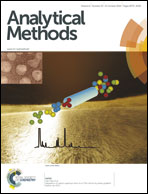Magnetic solid-phase extraction of proteins based on hydroxy functional ionic liquid-modified magnetic nanoparticles†
Abstract
Hydroxy functional ionic liquids have been first designed and modified on the surface of silica-coated magnetic Fe3O4 nanoparticles (MNPs) for the investigation of the extraction performance of proteins by magnetic solid-phase extraction (MSPE) and characterized by Fourier transform infrared spectroscopy (FTIR), transmission electron microscopy (TEM), vibrating sample magnetometer (VSM), X-ray diffraction (XRD) and thermogravimetric analysis (TGA). BSA was chosen as a model protein to investigate the effect of extraction parameters. Based on the single-factor experiment, an initial serial investigative test was used to identify the optimal conditions of the extraction, and the extraction efficiency could reach up to 86.92%. The RSD of extraction efficiencies in the precision, repeatability and stability experiments were 1.17% (n = 3), 3.79% (n = 3) and 4.82% (n = 3), respectively. Compared with the other four types of ionic liquids, hydroxy functional ionic liquids-modified magnetic nanoparticles have the highest extraction rates. The desorption of proteins was up to 94.91% when the concentrations of NaCl were greater than 1.1 mol L−1. Nearly 95% of MNPs could be recovered from each run, and extraction rates decreased significantly after five runs.


 Please wait while we load your content...
Please wait while we load your content...